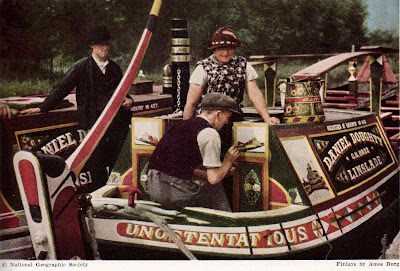Some time ago, we visited a National Trust property, just south of Birmingham. As with many such NT properties it had a second-hand book shop. Amidst a large collection of non-descript paperbacks there was a small collection of travel books. I was expecting to see some canal-related books but I was disappointed. However, hiding in the corner of the shelf was a set of slim canal booklets. It was a set of cruising guides published in the late 1950s and early 1960s by British Waterways.
 Number 1 in the series from the late 1950s
Number 1 in the series from the late 1950sAt the time I had not come across these booklets before. Each guide, which was in good condition cost me around 90p, but I rapidly realised that I hadn’t got a complete set of fourteen. When I returned home I set about obtaining a full set and found that ebay had several for sale. As a result, over the following weeks I got myself a “mixed vintage” set of fourteen. The earlier booklets mostly retailed when new for 3s 6d but the later ones, dated 1967, cost as much as 5s.
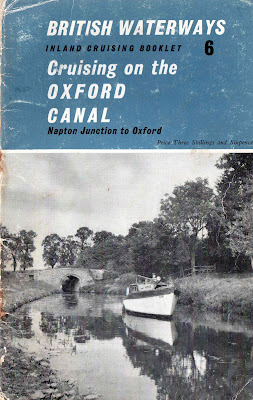 Number 6 from 1965 with a photo on the cover
Number 6 from 1965 with a photo on the coverThe booklets were originally published to support BW’s effort to increase hire boating on the system. The first booklets give lots of details of BW's own hire-craft fleet. My earliest example has details of the Water Class Hire Cruisers. You will be pleased to hear that
Water Arabis, a shortened former station working boat and available from Chester, was 46ft long and had six berths with Dunlopillo mattresses and electric lighting. The booklet also invited boat owners to bring their boats onto the canals. A boat over 50ft boat could be moored in the late 1950s at a BW lay-by or basin at the cost of £6 13s 4d per six month period! And a yearly licence for the whole of the BW system for the same boat cost £15. I don’t actually know the exact date of the publication of this volume but the charges are quoted as being valid for September 1957.
The booklets are printed onto good quality paper and have some excellent monochrome pictures illustrating the area around and on the waterways described. The Llangollen booklet, for example, has a total of 12 pictures. All booklets also included a map of the full waterways system, as it existed at that time, printed on rice paper.
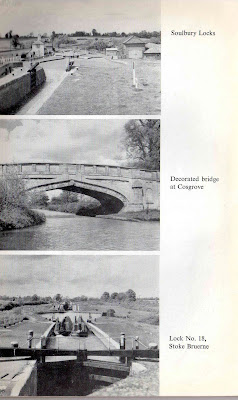
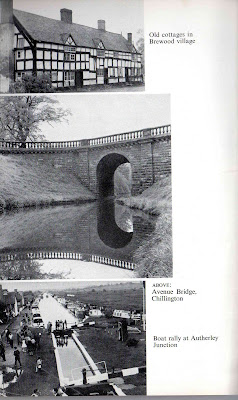
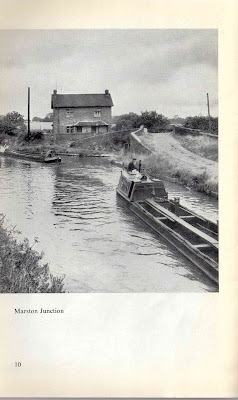 Some examples of the photographs in the booklets
Some examples of the photographs in the bookletsThe fourteen volumes are:
1 Llangollen Canal
2 Trent Waterway
3 Lee & Stort Navigations
4 Staffordshire & Worcestershire Canal
5 Shropshire Union Canal
6 Oxford Canal
7 Fossdyke and Witham Navigations
8 Grand Union Canal Part 1 (Brentford to Braunston)
9 Grand Union Canal Part 2 (Braunston to Birmingham)
10 Grand Union Canal Part 3 (Norton to Trent Lock)
11 Macclesfield Canal
12 Trent & Mersey Canal Part 1 (Trent Lock to Great Haywood)
13 Trent & Mersey Canal Part 2 (Great Haywood to Preston Brook)
14 Severn Waterway
The booklets are a wonderful record of early pleasure cruising. The pictures feature wooden cruisers of limited length with a few working boats in operation. The adverts are also very evocative. There are hire cruisers available from Maid Line and Swan Line. The Canal Museum at Stoke Bruerne gets a full page advert in the Grand Union volumes, with admission costing 1s. There are also some excellent adverts for Stuart Turner marine engines with interesting illustrations. My 1965 edition covering the Southern Grand Union also has an advert for the Aylesbury Boat Company operating from the basin in the town with a brokerage. In the same volume there are adverts for the Bletchley Boat Co., Willow Wren Hire Cruisers Ltd, and Blue Line at Braunston. The Millhouse Inn at Braunston, which is very well known to us, is advertised as the Rose & Castle Inn.
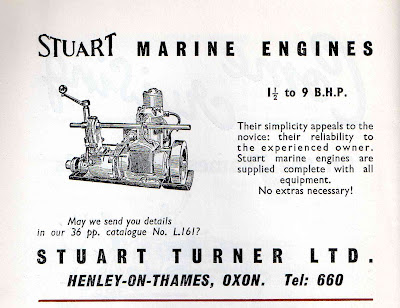
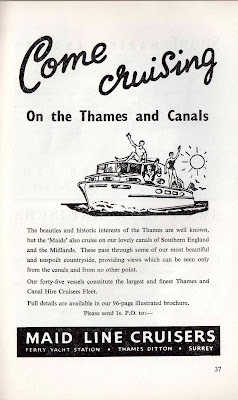 Adverts from 1960
Adverts from 1960But the best feature is the maps! When we took up serious boating in 1996 we bought Nicholson guides. We enjoyed the layout of the maps where canals were straightened to make them go up and down the page; I think they are easier to use than the more geographic modern coloured versions. The older Nicholson maps were also laid out in ways that enable users to make their own notes in the “empty areas” alongside mooring places and locks. Some of our early Nicholsons are full of our useful notes.
But these BW booklets have even better maps. Presumably taking their lead from the highly figurative London Underground map, the guides make all canals perfectly straight and adjust other features, including the distance scale, to suit. The useful information running in the column alongside the map is highly informative, both in terms of history and facilities. If the information was up-to-date I think I would use them today because there are particularly simple to use.
Some volumes in my set have been well-used although their condition is still good. One of my set was reduced to 60p because somebody had added cruising notes. I really like that volume because it records where the boater moored-up, turned, had coffee and lunch, took on water and even got very wet in the rain; nothing changes. Best of all, they even recorded that a man with warts on his neck helped them through a lock!
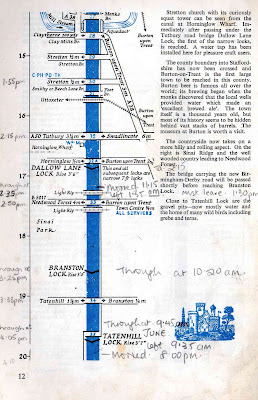 A well annotated map! (including timings)
A well annotated map! (including timings)Look out for these booklets, they are regularly for sale on ebay for very little money, but don’t expect to get a full set with one publication date.
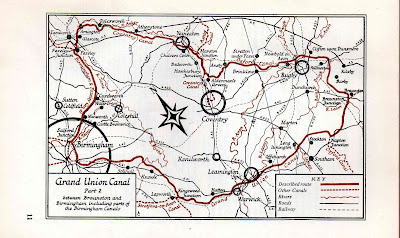 An early version of the Warwickshire Ring? - circa 1959
An early version of the Warwickshire Ring? - circa 1959As a postscript, the canals are shown in brown in early editions but become blue in later editions! Did the marketing department realise that it helps if water is shown in blue.
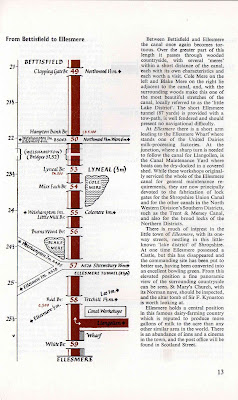 Brown canal map from an early edition
Brown canal map from an early edition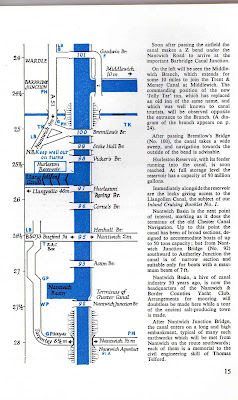 Blue canal map from a later edition
Blue canal map from a later edition




